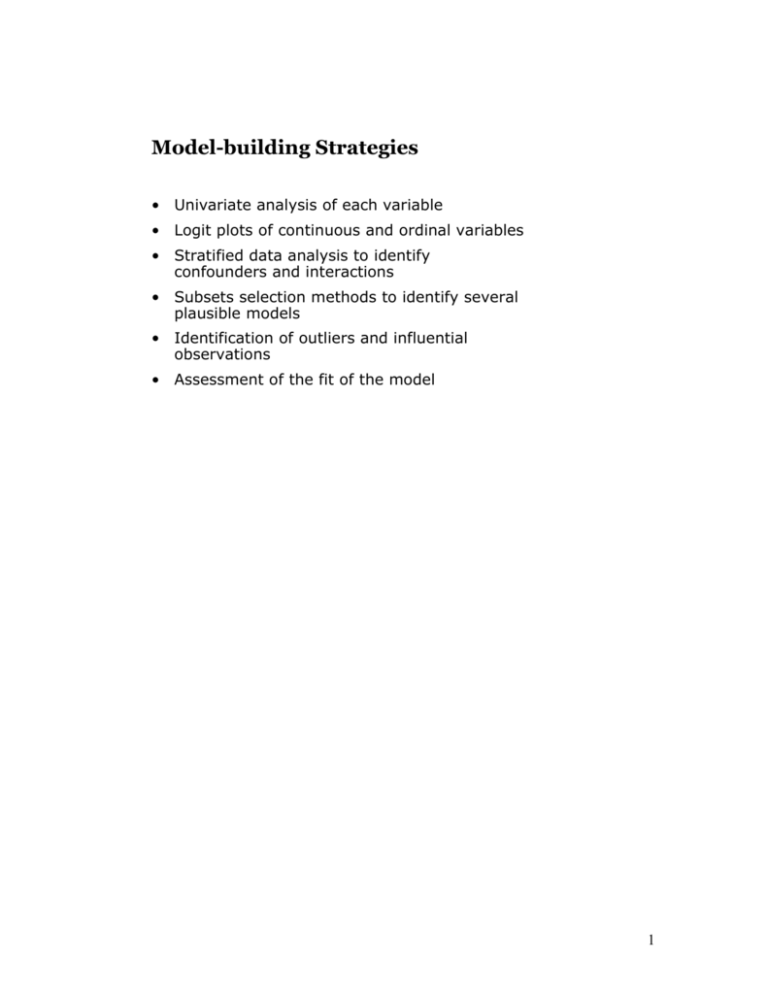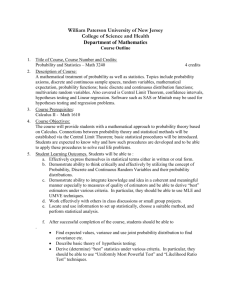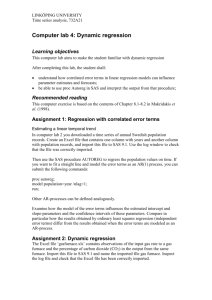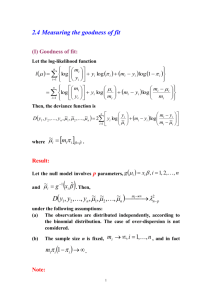Logistic Regression Model Selection and Model Diagnosis
advertisement

Model-building Strategies
• Univariate analysis of each variable
• Logit plots of continuous and ordinal variables
• Stratified data analysis to identify
confounders and interactions
• Subsets selection methods to identify several
plausible models
• Identification of outliers and influential
observations
• Assessment of the fit of the model
1
Automatic Model Selection Methods
1. Model Selection Criteria
(1) Score Chi-square criteria
(1) AICp=-2logeL(b)+2p
(2) SBCp=-2logeL(b)+ploge(n)
n
n
i 1
i 1
'
'
Where logeL(b) Yi ( X i b) log e [1 exp( X i b)]
Promising models will yield relatively small values for these
criteria.
(4) A third criterion that is frequently provided by SAS is -2logeL(b).
For this criterion, we also seek models giving small values. A drawback
of this criterion is that it will never increase as terms are added to the
model, because there is no penalty for adding predictors. This is
analogous to the use of SSEp or R p2 in multiple linear regression.
2. Best Subsets Procedures
“Best” subsets procedures were discussed in Section 9.4 in ALSM in the
context of multiple linear regression. Recall that these procedures
identify a group of subset models that give the best values of a specified
criterion. We now illustrate the use of the best subset procedure based on
Score chi-square. SAS doesn’t provide automatic best subsets procedures
based on AIC and SBC criteria.
Example:
1 disease present
Y
0 disease absent
X1 Age
1 Middle Class
X2
others
0
socioeconomic status
1 Lower Class
X3
others
0
Case
i
Age
Xi1
Socioeconomic
Status
Xi2
Xi3
City
Sector
Xi4
Disease
Status
Yi
Fitted
Value
1
2
3
4
5
6
.
33
35
6
60
18
26
.
0
0
0
0
0
0
.
0
0
0
0
1
1
0
0
0
0
0
0
.
0
0
0
0
1
0
.
.209
.219
.106
.371
.111
.136
.
98
35
0
1
0
0
.171
π̂ i
1 city sector 2
X4
0 city sector 1
Study purpose: assess the strength of the association between each of the
predictor variables and the probability of a person having contracted the
disease
2
SAS CODE 1 (Score Chi-square):
data ch14ta03;
infile 'c:\stat231B06\ch14ta03.txt'
DELIMITER='09'x;
input case x1 x2 x3 x4 y;
proc logistic data=ch14ta03;
model y (event='1')=x1 x2 x3
x4/selection=score;
run;
SAS OUTPUT1:
Regression Models Selected by Score Criterion
Number of
Variables
Score
Chi-Square
1
1
1
1
14.7805
7.5802
3.9087
1.4797
x4
x1
x3
x2
2
2
2
2
2
2
19.5250
15.7058
15.3663
10.0177
9.2368
4.0670
x1
x3
x2
x1
x1
x2
x4
x4
x4
x3
x2
x3
3
3
3
3
20.2719
20.0188
15.8641
10.4575
x1
x1
x2
x1
x2
x3
x3
x2
4
20.4067
x1 x2 x3 x4
Variables Included in Model
x4
x4
x4
x3
3. Forward, Backward Stepwise Model Selection
When the number of predictors is large (i.e., 40 or more) the use of allpossible-regression procedures for model selection may not be feasible. In
Such cases, forward, backward or stepwise selection procedures are
generally employed. The decision rule for adding or deleting a predictor
variable in SAS is based on wald chisquare statistics.
SAS CODE 2 (Forward selection):
data ch14ta03;
infile 'c:\stat231B06\ch14ta03.txt'
DELIMITER='09'x;
input case x1 x2 x3 x4 y;
SAS OUTPUT2:
Summary of Forward Selection
Step
1
2
Effect
Entered
x4
x1
DF
Number
In
Score
Chi-Square
Pr > ChiSq
1
1
1
2
14.7805
5.2385
0.0001
0.0221
Analysis of Maximum Likelihood Estimates
proc logistic data=ch14ta03;
model y (event='1')=x1 x2 x3
x4/selection=forward;
run;
If you want to use backward selection
procedure, you can specify
selection=backward; If you want to use
stepwise selection procedure, you can
specify selection=stepwise.
Parameter
DF
Estimate
Standard
Error
Wald
Chi-Square
Pr > ChiSq
Intercept
x1
x4
1
1
1
-2.3350
0.0293
1.6734
0.5111
0.0132
0.4873
20.8713
4.9455
11.7906
<.0001
0.0262
0.0006
Odds Ratio Estimates
Effect
Point
Estimate
95% Wald
Confidence Limits
x1
1.030
1.003
1.057
x4
5.330
2.051
13.853
Test for Goodness of Fit
3
1. Pearson Chi-Square Goodness of Fit Test:
It can detect major departures from a logistic response function,
but is not sensitive to small departures from a logistic response
function
Hypothesis: H0: E{Y}=[1+exp(-X)]-1
Ha: E{Y}[1+exp(-X)]-1
Test Statistic:
c
1
2
j1 k 0
(O jk E jk ) 2
E jk
~ χ 2 (c p)
P is the number of predictor variables+1;
c is the distinct combinations of the predictor variables;
Oj0= the observed number of 0 in the jth class;
Oj1= the observed number of 1 in the jth class;
Ej0= the expected number of 0 in the jth class when H0 is true;
Ej1= the expected number of 1 in the jth class when H0 is true
Decision Rule:
If Χ 2 χ 2 (1 α; c p), conclude H 0
If Χ 2 χ 2 (1 α; c p), conclude H a
2. Deviance Goodness of Fit Test:
The deviance goodness of fit test for logistic regression models
is completely analogous to the F test for lack of fit for simple
and multiple linear regression models.
Hypothesis: H0: E{Y}=[1+exp(-X)]-1
Ha: E{Y}[1+exp(-X)]-1
Likelihood Ratio Statistic:
Full Model: E{Yij}=j, j=1,2,...c
Reduced Model: Yij=[1+exp(-Xj`)]-1
c is the distinct combinations of the predictor variables;
c
1 ˆ j
L(R)
ˆ
G 2 2log e
2 [Y.j log e ( p jj ) (n j Y. j ) log e (
)] DEV(X 0 , X1 ,...X p1 )
1 pj
j1
L(F)
Decision Rule:
4
If Χ 2 χ 2 (1 α; c p), conclude H 0
If Χ 2 χ 2 (1 α; c p), conclude H a
Level
Price
Reduction
Number of
Households
j
Xj
nj
1
2
3
4
5
5
10
15
20
30
200
200
200
200
200
Number of
Coupons
Redeemed
Y..j
30
55
70
100
137
Proportion
of
Coupons
Redeemed
pj
MondelBased
Estimate
.150
.275
.350
.500
.685
.1736
.2543
.3562
.4731
.7028
̂ j
SAS CODE:
SAS OUTPUT:
data ch14ta02;
infile 'c:\stat231B06\ch14ta02.txt';
input x n y pro;
run;
proc logistic data=ch14ta02;
/*The option scale=none is specified
/*to produce the deviance and */
/*Pearson goodness-of-fit analysis*/
model y/n=x /scale=none;
Deviance and Pearson Goodness-of-Fit Statistics
run;
Note: To request the Pearson ChiSquare Goodness of Fit test, we use
the aggregate and scale options on
the model statement, i.e. “ model
y/n=x /aggregate=(x)scale=pearson;”.
Criterion
Value
DF
Value/DF
Pr > ChiSq
Deviance
Pearson
2.1668
2.1486
3
3
0.7223
0.7162
0.5385
0.5421
Number of events/trials observations: 5
Since p-value=0.5385 for deviance
goodness of fit test and p-value=0.5421
for pearson chi-square goodness of fit
test, we conclude H0 that the logistic
regression response function is
appropriate.
3. Hosmer-Lemeshow Goodness of Fit Test
5
This test is designed for either unreplicated data sets or data sets with few
replicates through grouping of cases based on the values of the estimated
probabilities. The procedure consists of grouping the data into classes
with similar fitted values ̂ i , with approximately the same number of
cases in each class. Once the group are formed, the Pearson chi-square
test statistic is used
SAS CODE (the disease outbreak example)
SAS OUTPUT:
data ch14ta03;
infile 'c:\stat231B06\ch14ta03.txt'
DELIMITER='09'x;
input case x1 x2 x3 x4 y;
run;
Partition for the Hosmer and Lemeshow Test
proc logistic data=ch14ta03;
model y (event='1')=x1 x2 x3
x4/lackfit;
run;
We use the lackfit option on the
proc logistic model statement.
Partial results are found in the SAS
OUTPUT on the right.
Group
1
2
3
4
5
6
7
8
9
10
Total
10
10
11
10
10
10
10
11
10
6
Observed
0
1
2
1
3
4
7
3
5
5
y = 1
Expected
0.79
1.02
1.51
1.78
2.34
3.09
3.91
5.51
6.32
4.75
y = 0
Observed
Expected
10
9.21
9
8.98
9
9.49
9
8.22
7
7.66
6
6.91
3
6.09
8
5.49
5
3.68
1
1.25
Hosmer and Lemeshow Goodness-of-Fit Test
Chi-Square
DF
Pr > ChiSq
9.1871
8
0.3268
Note that X2=9.189(p-value=0.327) and
the text reports X2=1.98(p-value=0.58).
Although the difference in magnitudes of
the test statistic is large, the p-values lead
to the same conclusion. The discrepancy
is due to the test statistics being based on
different contingency table, i.e., 2 by 5
versus 2 by 10. The use of 20 cells
(210) decreases the expected
frequencies per cell relative to the use of
10 cells (25). However, Hosmer and
Lemeshow take a liberal approach to
expected values and argue that their
method is an accurate assessment of
goodness of fit.
Logistic Regression Diagnostics
Residual Analysis and the identification of influential cases.
6
1. Logistic Regression Residuals
(a) Pearson Residuals
rPi
Yi ˆ i
ˆ i (1 ˆ i )
Pearson Chi-Square Goodness of Fit statistic
n
1
2
(Oij E ij ) 2
i 1 j0
(b)
rSPi
E ij
(Yi ˆ i ) 2 n 2
r
ˆ i (1 ˆ i ) i1 Pi
i 1
n
Studentized Pearson Residuals
rPi
1 h ii
, where
ˆ X) 1 X' W
ˆ 1/ 2 , ,
h ii is the ith diagonal element of the matrix H Ŵ 1/2 X( X' W
ˆ is the n n diagonal matrix wit h elements ˆ (1 ˆ )
W
i
i
(c)
Deviance Residuals
devi sign (Yi - ˆ i ) - 2[Yi log e (ˆ i ) (1 Yi ) log e (1 ˆ i )
where sign (Yi - ˆ i ) is positive if Yi ˆ i and negative when Yi ˆ i
n
2
(devi ) DEV(X 0 , X1 ,..., X p1 )
i 1
2. Detection of Influential Observations
We consider the influence of individual binary cases on three aspects of
the analysis (1) The Pearson Chi-Square statistic (2) The deviance
statistic (3) the fitted linear predictor, ̂i'
Influence on Pearson Chi-Square and the Deviance Statistics.
2
ith delta chi-square statistic: Xi2 X2 X(2i ) rSP
i
X (2i ) denotes Pearson Chi - Square Statistic when case i is deleted
2
ith delta deviance statistic: devi DEV DEV(i) hiirSP
devi2
i
DEV(i ) denotes Deviance Statistic when case i is deleted
As we can see, Xi2 and devi give the change in the Pearson chi-square and deviance
statistics, respectively, when the ith case is deleted. They therefore provide measures of the
influence of the ith case on these summary statistics.
The interpretation of the delta chi-square and delta deviance statistics is not
as simple as those statistics that we used for regression diagnostic. This is
because the distribution of the delta statistics is unknown except under
7
certain restrictive assumptions. The judgment as to whether or not a case is
outlying or overly influential is typically made on the basis of a subjective
visual assessment of an appropriate graphic. Usually, the delta chi-square
and delta deviance statistics are plotted against case number I, against
ˆ i , or against ˆ i' . Extreme values appear as spikes when plotted against case
number, or as outliers in the upper corners of the plot when plotted against
ˆ i , or against ˆ i'
Influence on the Fitted Linear Predictor: Cook’s Distance.
The following one-step approximation is used to calculate Cook’s Distance:
Di
rp2i h ii
p(1 h ii ) 2
Extreme values appear as spikes when plotted against case number.
Note that influence on both the deviance (or Pearson chi-square) statistic and
the linear predictor can be assessed simultaneously using a proportional
influence or bubble plot of the delta deviance ( or delta chi-square) statistics,
in which the area of the plot symbol is proportional to Di.
8
The disease outbreak example.
SAS CODE:
/*In the output statement immediately following the model statement*/
/*we set yhat=p(estimated probability, ̂ i ),chires=reschi(pearson residual, rpi ),*/
/*devres=resdev(deviance residual, devi),difchsq=difchisq(delta chi-square
i2 )*/
/*difdev=difdev(delta deviance, dev i ),hatdiag=h(diagonal elements of the hat matrix*/
/*Here p,reschi,resdev,difchisq, difdev and h are SAS key words for the respective */
/*variables. We then output them into results1 so that the data for all variables will*/
/*be assessable in one file. We then use equation 14.81 (text page 592) to find rsp */
/*(studentized Pearson residual, rspi) and equation 14.87 (text page 600) to find */
/*cookd (COOK's Distance, Di) [SAS OUTPUT1].*/
/*The INFLUENCE option [SAS OUTPUT 2] and the IPLOTS option are specified to display*/
/*the regression diagnostics and the index plots [SAS OUTPUT 3]*/
/*The values in SAS OUTPUT 1 can be used to generate various pltos as displayed*/
/*in the text [SAS OUTPUT 4]. For example, we can generate Figure 14.15 (c) and(d),*/
/*text page 600 by using proc gplot to plot (difchisq difdev) *yhat; we can generate */
/*Figure 14.16 (c) by using proc gplot with bubble difdevsqr*yhat=cookd;*/
/*we can generate Figure 14.16 (b)by using proc gplot with */
/*symbol1 color=black value=none interpol=join; plot cookd*case; */
data ch14ta03;
infile 'c:\stat231B06\ch14ta03.txt' DELIMITER='09'x;
input case x1 x2 x3 x4 y;
run;
ods html;
ods graphics on; /*ods graphics version of plots are produced*/
proc logistic data=ch14ta03;
model y (event='1')=x1 x2 x3 x4 /influence iplots ;
output out=results1 p=yhat reschi=chires resdev=devres difchisq=difchisq difdev=difdev
h=hatdiag;
run;
data results2;
set results1;
rsp=chires/(sqrt(1-hatdiag));
cookd=((chires**2)*hatdiag)/(5*(1-hatdiag)**2);
difdevsqr=difdev**2;
proc print;
var yhat chires rsp hatdiag devres difchisq difdev cookd;
run;
proc gplot data=results2;
plot (difchisq difdev)*yhat;
run;
proc gplot data=results2;
bubble difdevsqr*yhat=cookd;
run;
proc gplot data=results2;
symbol1 color=black value=none interpol=join;
plot cookd*case;
run;
ods graphics off;
ods html close;
9
SAS OUTPUT 1:
The SAS System
Obs
yhat
chires
rsp
hatdiag
devres
difchisq
difdev
cookd
1
0.20898
-0.51399
-0.52425
0.03873
-0.68473
0.27483
0.47951
0.002215
2
0.21898
-0.52951
-0.54054
0.04041
-0.70308
0.29219
0.50612
0.002461
3
0.10581
-0.34400
-0.34985
0.03320
-0.47295
0.12240
0.22774
0.000841
.
.
.
.
.
.
.
.
.
.
.
.
.
.
.
.
.
.
.
.
.
.
.
.
.
.
.
96
0.11378
-0.35832
-0.36297
0.02545
-0.49152
0.13175
0.24494
0.000688
97
0.09190
-0.31812
-0.32202
0.02406
-0.43910
0.10370
0.19530
0.000511
98
0.17126
-0.45459
-0.46289
0.03555
-0.61294
0.21427
0.38332
0.001580
SAS OUTPUT 2:
Regression Diagnostics
Case
Number
Covariates
x1
x2
x3
Pearson
Residual
Deviance
Residual
Hat
Matrix
Diagonal
Intercept
DfBeta
x1
DfBeta
x2
DfBeta
x3
DfBeta
x4
DfBeta
Confidence
Interval
Displacement
C
Confidence
Interval
Displacement
CBar
Delta
Deviance
Delta
ChiSquare
x4
1
33.0000
0
0
0
-0.5140
-0.6847
0.0387
-0.0759
-0.00487
0.0529
0.0636
0.0659
0.0111
0.0106
0.4795
0.2748
2
35.0000
0
0
0
-0.5295
-0.7031
0.0404
-0.0756
-0.0113
0.0546
0.0662
0.0689
0.0123
0.0118
0.5061
0.2922
3
6.0000
0
0
0
-0.3440
-0.4729
0.0332
-0.0645
0.0374
0.0323
0.0356
0.0352
0.00420
0.00406
0.2277
0.1224
.
0.0779
0.1059
0.1161
0.0637
0.0580
0.9852
0.6478
.
-0.0223
0.2675
-0.1725
0.2127
0.2073
4.6070
8.2311
.
0.00128
-0.0426
0.0258
0.00474
0.00461
0.2982
0.1627
96
19.0000
0
1.0000
0
-0.3583
-0.4915
0.0255
-0.0188
0.0131
0.00263
-0.0344
0.0220
0.00344
0.00335
0.2449
0.1317
97
11.0000
0
1.0000
0
-0.3181
-0.4391
0.0241
-0.0218
0.0208
0.00357
-0.0268
0.0183
0.00256
0.00250
0.1953
0.1037
98
35.0000
0
1.0000
0
-0.4546
-0.6129
0.0356
-0.00330
-0.0184
-0.00145
-0.0557
0.0316
0.00790
0.00762
0.3833
0.2143
10
SAS OUTPUT3:
The leverage plot (on the lower left corner) identifies case 48 as being somewhat
outlying in the X space- and therefore potentially influential
The index plots of the delta chi-square (on the upper right corner) and delta
deviance statistics (on the lower left corner) have two spikes corresponding to
cases 5 and 14.
SAS OUTPUT 4:
11
The plots of the delta chi-square and delta deviance statistics against the
model-estimated probabilities also show that cases 5 and 14 again stand out
– this time in the upper left corner of the plot. The results in the index plots of
the delta chi-square and delta deviance statistics in SAS OUTPUT3 and the
plots in SAS OUTPUT4 suggest that cases 5 and 14 may substantively affect
the conclusions
The plot of Cook’s distances indicates that case 48 is indeed the most
influential in terms of effect on the linear predictor. Note that cases 5 and 14
– previously identified as most influential in terms of their effect on the
Pearson chi-square and deviance statistics- have relatively less influence on
the linear predictor. This is shown also by the proportional-influence plot.
The plot symbols for these cases are not overly large, indicating that these
cases are not particularly influential in terms of the fitted linear predictor
values. Case 48 was temporarily deleted and the logistic regression fit was
obtained. The results were not appreciably different from those obtained
from the full data set, and the case was retained.
Inferences about Mean Response
12
For the disease outbreak example, what is the probability of 10-year-old persons of lower
socioeconomic status living in city sector 1 having contracted the disease?
Pointer Estimator:
Denote the vector of the levels of the X variables for which is to be
estimated by Xh:
1
X
h1
Xh X h2
X h,p 1
The point estimator of h will be denoted by
ˆ h [1 exp(Xh ' b)]1
where b is the vector of estimated regression coefficients.
Interval Estimation
Step 1: calculate confidence limits for the logit mean response
ˆ h' Xh' b,
h ' .
s 2{ˆ h' } Xh' s 2{b}Xh ,
where s 2{b} is the estimated approximat e variance - covariance matrix of b in (14.51)
of text ALSM when n is large
Approximate 1- large-sample confidence limits for the logit mean response
h ' are:
L ˆ h' z (1 - / 2)s{ˆ 'h }
U ˆ h' z (1 - / 2)s{ˆ 'h }
Step 2: From the fact that h [1 exp(h' )]1 , the approximate 1- largesample confidence limits L* and U* for the mean response h are:
L* [1 exp( L)]1
U* [1 exp( U)]1
Simultaneous Confidence Intervals for Several Mean Responses
When it is desired to estimate several mean response h corresponding to
different Xh vectors with family confidence coefficient 1-, Bonferroni
simultaneous confidence intervals may be used.
Step 1: The g simultaneous approximate 1- large-sample confidence limits
for the logit mean response h ' are:
k
13
L ˆ h' k z (1 - / 2g)s{ˆ 'h k }
U ˆ h' k z (1 - / 2g)s{ˆ 'h k }
Step 2: The g simultaneous approximate 1- large-sample confidence limits
for the mean response h are:
k
L* [1 exp( L)]1
U* [1 exp( U)]1
Example (disease outbreak)
(1) It is desired to find an approximate 95 percent confidence interval for the
probability h that persons 10 years old who are of lower socioeconomic status
and live in sector 1 have contracted disease.
/*the outest= and covout options create*/
/*a data set that contains parameter */
/*estimates and their covariances for */
/*the model fitted*/
proc logistic data=ch14ta03 outest=betas
covout;
model y (event='1')= x1 x2 x3 x4 /covb;
run;
/*add column for zscore*/
data betas;
set betas;
zvalue=probit(0.975);
run;
proc iml;
use betas;
read all var
read all var
read all var
read all var
read all var
read all var
{'Intercept'} into a1;
{'x1'} into a2;
{'x2'} into a3;
{'x3'} into a4;
{'x4'} into a5;
{'zvalue'} into zvalue;
/*define the b vector*/
b=t(a1[1]||a2[1]||a3[1]||a4[1]||a5[1]);
/*define variance-covariance matrix for b*/
covb=(a1[2:6]||a2[2:6]||a3[2:6]||a4[2:6]||a5[2:6]);
/*Define xh matrix*/
xh={1,10,0,1,0};
/*find the point estimator of logit mean*/
/* based on equation above the equation */
/*(14.91) on page 602 of text ALSM*/
logitpi=xh`*b;
/*find the estimated variance of logitpi*/
/*based on the equation (14.92)on page 602*/
/*of text ALSM*/
sbsqr=xh`*covb*xh;
/*find confidence limit for logit mean*/
L=logitpi-zvalue*sqrt(sbsqr);
U=logitpi+zvalue*sqrt(sbsqr);
L=L[1];
U=U[1];
/*find confidence limit L* and U* for*/
/*probability based on equation on page 603*/
/*of text ALSM*/
Lstar=1/(1+EXP(-L));
Ustar=1/(1+EXP(-U));
print L U Lstar Ustar;
quit;
SAS OUTPUT
L
U
LSTAR
USTAR
-3.383969 -1.256791 0.0328002 0.2215268
Prediction of a New Observation
1. Choice of Prediction Rule
14
1 if ˆ h is large
outcome
0 if ˆ h is small
Where is the cutoff point?
(1) Use .5 as the cutoff
1 if ˆ h .5
(a) it is equally likely in the population of interest that
outcome
0 if ˆ h .5
outcomes 0 and 1 will occur; and
(b) the costs of incorrectly predicting 0 and 1 are
approximately the same
(2) Find the best cutoff for the data set on which the multiple logistic regression
model is based.
For each cutoff, the rule is employed on the n cases in the model-building data set and
the proportion of cases incorrectly predicted is ascertained. The cutoff for which the
proportion of incorrect predictions is lowest is the one to be employed.
(a) the data set is a random sample from the relevant population, and thus reflects
the proper proportions of 0s and 1s in the population
(b) the costs of incorrectly predicting 0 and 1 are approximately the same
(3) Use prior probabilities and costs of incorrect predictions in determining the
cutoff.
(a) prior information is available about the likelihood of 1s and 0s in the population
(b) the data set is not a random sample from the population
(c) the cost of incorrectly predicting outcome 1 differs substantially from the cost
of incorrectly predicting outcome 0.
For the disease outbreak example, we assume
that the cost of incorrectly predicting that a
person has contracted the disease is about the
same as the cost of incorrectly predicting that a
person has not contracted the disease. Since a
random sample of individual was selected in
the two city sectors, the 98 cases in the study
constitute a cross section of the relevant
population. Consequently, information is
provided in the sample about the proportion of
persons who have contracted the disease in
the population. Here we wish to obtain the best
cutoff point for predicting the new observation
will be “1” or “0”.
1 if ˆ h .316
0 if ˆ h .316
First rule: outcome
The estimated proportion of persons who
had contracted the disease is 31/98=.316
1 if ˆ h .325
0 if ˆ h .325
Second rule: outcome
This is the optimal cutoff
SAS CODE:
SAS OUTPUT:
/*save the predicted probability */
/*in a variable named yhat*/
/*(p=yhat) and then set newgp=1*/
The FREQ Procedure
Table of y by newgp
y
newgp
Frequency‚
0‚
1‚
Total
15
/*if yhat is greater than or */
/*equal to 0.316,otherwise*/
/* newgp=0. We then form a 2 by 2*/
/*table of Y values (disease */
/*versus nondiseased) by newgp */
/*values (predicted diseased */
/*versus predicted nondiseases)*/
/* the outroc option on the model*/
/*statement saves the data */
/*necessary to produce the ROC*/
/*curve in a data file named roc*/
/*(outroc=roc). Two of the */
/*variables stored in roc data*/
/*are _sensit_(sensitivity)*/
/*and _1mspec_(1-specificity)*/
/*In the proc gplot we plot */
/*_sensit_ against _1mspec_*/
/* to form the ROC curve*/
proc logistic data=ch14ta03
descending;
model y=x1 x2 x3 x4/outroc=roc;
output out=results p=yhat;
run;
data results;
set results;
if yhat ge .316 then newgp=1; else
newgp=0;
ƒƒƒƒƒƒƒƒƒˆƒƒƒƒƒƒƒƒˆƒƒƒƒƒƒƒƒˆ
0 ‚
49 ‚
18 ‚
ƒƒƒƒƒƒƒƒƒˆƒƒƒƒƒƒƒƒˆƒƒƒƒƒƒƒƒˆ
1 ‚
8 ‚
23 ‚
ƒƒƒƒƒƒƒƒƒˆƒƒƒƒƒƒƒƒˆƒƒƒƒƒƒƒƒˆ
Total
57
67
31
41
98
There were 8+23=31 (false negatives+true
positives)diseased individuals and 49+19=67
(true negatives +false positives) non-diseased
individuals. The fitted regression function
correctly predicted 23 of the 31 diseased
individuals. Thus the sensitivity is calculated as
true positive/(false negative+true
positive)=23/31=0.7419 as reported on text
page 606. The logistic regression function’s
specificity is defined as true negative/(false
positive+true negative)=49/67=0.731. This is
not consistent with text page 607 where the
specificity is reported as 47/67=0.7014. The
difference comes from the regression model
fitted. We fit the regression model based on
using age, status and sector as predictor. In
text, they fit the regression model based on
using age and sector only.
Se n s i t i v i t y
1. 0
0. 9
0. 8
0. 7
proc freq data=results;
table y*newgp/ nopercent norow
nocol;
run;
0. 6
0. 5
0. 4
0. 3
0. 2
0. 1
/*ROC curve*/
proc gplot data=roc;
symbol1 color=black value=none
interpol=join;
plot _SENSIT_*_1MSPEC_;
0. 0
0. 0
0. 1
0. 2
0. 3
0. 4
0. 5
1 -
0. 6
0. 7
0. 8
0. 9
1. 0
Sp e c i f i c i t y
run;
Validation of Prediction Error Rate
The reliability of the prediction error rate observed in the model-building
data set is examined by applying the chosen prediction rule to a validation
16
data set. If the new prediction error rate is about the same as that for the
model-building data set, then the latter gives a reliable indication of the
predictive ability of the fitted logistic regression model and the chosen
prediction rule. If the new data lead to a considerably higher prediction error
rate, then the fitted logistic regression model and the chosen prediction rule
do not predict new observations as well as originally indicated.
For the disease outbreak example, the fitted logistic regression
function based on the model-building data set is
ˆ [1 exp(3.8877 .02975 X1 .4088 X 2 .30525 X 3 1.5747 X 4 )]1
We use this fitted logistic regression function to calculate estimated
probabilities ̂ h for cases 99-196 in the disease outbreak data set in Appendix
C.10. The chosen prediction rule is
1 if ˆ h .325
,
outcome
0 if ˆ h .325
We want to classify observations in the validation data set.
data disease;
infile 'c:\stat231B06\appenc10.txt';
input case age status sector y other ;
x1=age;
/*code the status with two dummy var*/
if status eq 2 then x2=1; else x2=0;
if status eq 3 then x3=1; else x3=0;
/*code sector with one dummy var*/
if sector eq 2 then x4=1; else x4=0;
/*calculate estimated probabilities*/
/*based on fitted logistic model*/
yhat=(1+exp(2.3129-(0.02975*x1)(0.4088*x2)+(0.30525*x3)(1.5747*x4)))**-1;
/*make group predictions based on */
/*the specified prediction rule*/
if yhat ge .325 then newgp=1; else
newgp=0;
run;
/*generate the frequency table for */
/*the validation data set */
/*(cases 98-196)*/
proc freq;
where case>98;
table y*newgp/nocol nopct;
run;
The FREQ Procedure
Table of y by newgp
y
newgp
Frequency‚
Row Pct ‚
0‚
1‚
ƒƒƒƒƒƒƒƒƒˆƒƒƒƒƒƒƒƒˆƒƒƒƒƒƒƒƒˆ
0 ‚
44 ‚
28 ‚
‚ 61.11 ‚ 38.89 ‚
ƒƒƒƒƒƒƒƒƒˆƒƒƒƒƒƒƒƒˆƒƒƒƒƒƒƒƒˆ
1 ‚
12 ‚
14 ‚
‚ 46.15 ‚ 53.85 ‚
ƒƒƒƒƒƒƒƒƒˆƒƒƒƒƒƒƒƒˆƒƒƒƒƒƒƒƒˆ
Total
56
42
Total
72
26
98
The off-diagonal percentages indicate that
12(46.2%) of the 26 diseased individuals
were incorrectly classified (prediction error)
as non-diseased. Twenty-eight (38.9%) of
the 72 non-diseased individuals were
incorrectly classified as diseased. Note that
the total prediction error rate of 40.8%
=(28+12)/98 is considerably higher than
the 26.5% error rate based on the modelbuilding data set. Therefore the fitted
logistic regression model and the chosen
prediction rule do not predict new
observations as well as originally indicated.
17









